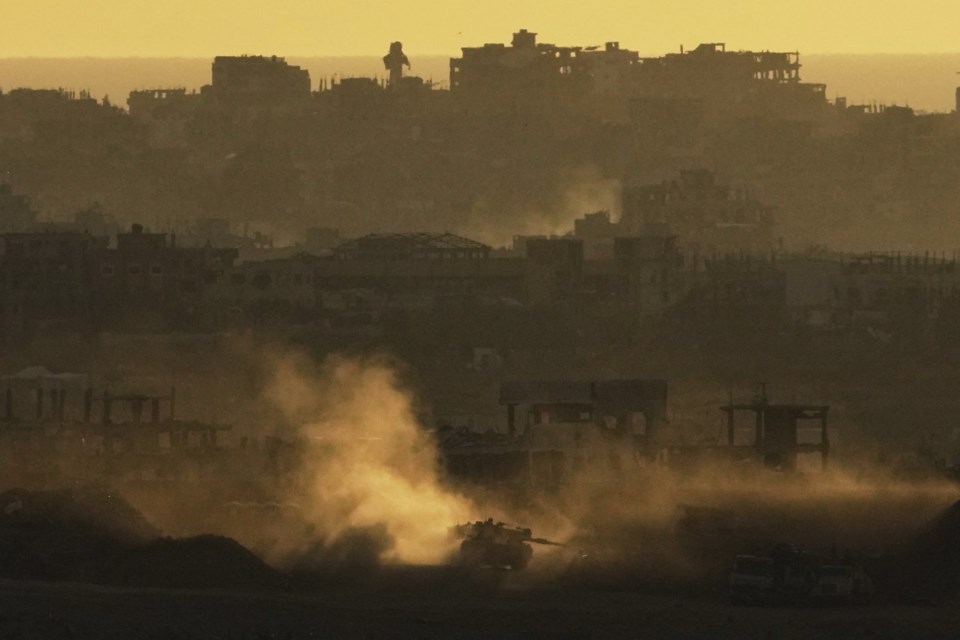TEL AVIV, Israel (AP) ÔÇö Israel approved plans on Monday to capture the entire Gaza Strip and remain in the territory for an unspecified amount of time, two Israeli officials said, in a move that if implemented would vastly expand Israel's operations in the Palestinian territory and likely bring fierce international opposition.
Israeli Cabinet ministers approved the plan in an early morning vote, hours after the Israeli military chief said the army was calling up tens of thousands of reserve soldiers.
The new plan, which the officials said was meant to help Israel achieve its war aims of defeating Hamas and freeing hostages held in Gaza, also would push hundreds of thousands of Palestinians to southern Gaza, what would likely exacerbate an already dire humanitarian crisis.
Since in mid-March, Israel has unleashed fierce strikes on the territory that have killed hundreds. It has captured swathes of territory and of Gaza. Before the truce ended, Israel , including food, fuel and water, setting off what is believed to the be the worst humanitarian crisis in nearly 19 months of war.
The ban on aid has prompted widespread hunger and .
Israel is trying to ratchet up pressure on Hamas
The Israeli officials said the plan included the ÔÇťcapturing of the strip and the holding of territories.ÔÇŁ The plan would also seek to prevent the militant Hamas group from distributing humanitarian aid, which Israel says strengthens the group's rule in Gaza. It also accuses Hamas of keeping the aid for itself to bolsters its capabilities. The plan also included powerful strikes against Hamas targets, the officials said.
The officials said Israel was in touch with several countries about to take over Gaza and relocate its population, under what Israel has termed ÔÇťvoluntary emigration" yet which has sparked condemnations from Israel's allies in Europe and the Arab world.
One of the officials said the plan would be implemented gradually. Both officials spoke on condition of anonymity because they were discussing military plans.
For weeks, Israel has been trying to ratchet up pressure on Hamas and prompt it to show more flexibility in ceasefire negotiations. But international mediators trying to bring the sides toward a new deal have struggled to do so. Israel's measures do not appear to have moved Hamas away from its negotiating positions.
The previous ceasefire was meant to lead the sides , but that goal has been a repeated sticking point in talks between Israel and Hamas. Israel says it wonÔÇÖt agree to end the war until Hamas is defeated. Hamas meanwhile has demanded an agreement that winds down the war.
Israel wants to prevent Hamas from handling aid
The Israeli officials did not disclose details on how the plan seeks to prevent Hamas from involvement in aid distribution. One said the ministers had approved ÔÇťthe option of aid distribution," without elaborating.
According to an internal memo circulated among aid groups and seen by The Associated Press, Israel told the United Nations that it will use private security companies to control aid distribution in Gaza. The U.N., in a statement Sunday, said it would not participate in the plan as presented to it, saying it violates its core principles.
The memo, sent to aid organizations on Sunday, detailed notes from a meeting between the Israeli defense body in charge of coordinating aid to Gaza, COGAT and the UN.
Under COGATÔÇÖs plan, all aid will enter Gaza through the Kerem Shalom crossing, letting approximately 60 trucks enter daily and distributing 20 kilograms of aid parcels directly to people on the day of entry, although their contents were unclear as was how many people will have access to the aid.
The memo said the aid will be distributed at logistics hubs, which will be run by private security companies. The memo said that facial recognition will be used to identify Palestinians at the hubs and SMS alerts will notify people in the area that they can collect aid.
The UN accuses Israel of wanting to control aid as a ÔÇśpressure tacticÔÇÖ
The U.N. said the plan would leave large parts of the population, including the most vulnerable, without supplies. It said the plan ÔÇťappears designed to reinforce control over life-sustaining items as a pressure tactic ÔÇô as part of a military strategy.ÔÇŁ
The memo says that the U.S. government has voiced clear support for Israel's plan, but itÔÇÖs unclear who would provide funding for the private military companies or the aid.
COGAT and the U.S. Embassy in Jerusalem did not immediately respond to a request for comment.
Earlier this week, about aid groupsÔÇÖ concerns that the hubs could end up permanently displacing Palestinians and forcing them to live in ÔÇťde facto internment conditionsÔÇŁ.
The war in Gaza began when Hamas-led militants attacked southern Israel, killing 1,200 people and taking about 250 hostages. Israel says 59 captives remain in Gaza, although about 35 are believed to be dead.
IsraelÔÇÖs offensive has killed more than 52,000 people in Gaza, many of them women and children, according to Palestinian health officials, who do not distinguish between combatants and civilians in their count.
The fighting has displaced more than 90% of GazaÔÇÖs population, often multiple times, and turned Gaza into an uninhabitable moonscape.
Israel occupied Gaza in the 1967 Mideast war and withdrew troops and settlers in 2005. Two years later, Hamas took over and has controlled the territory since.
___
Mednick reported from Jerusalem.
___
Follow APÔÇÖs war coverage at
Tia Goldenberg And Sam Mednick, The Associated Press




